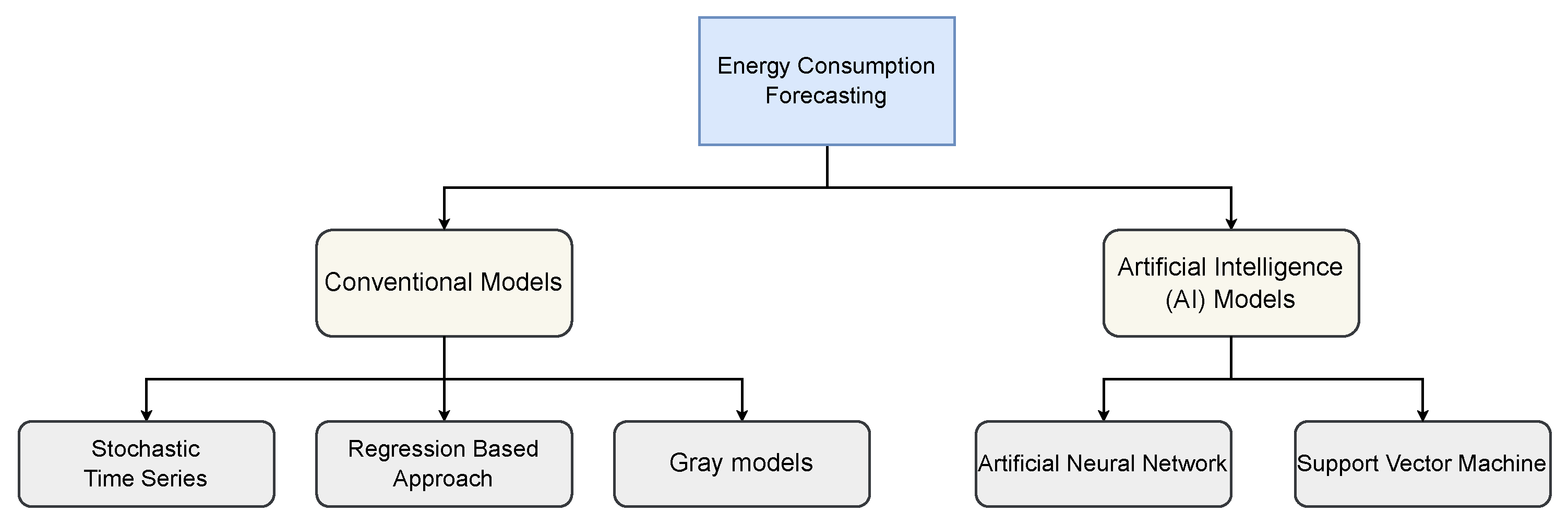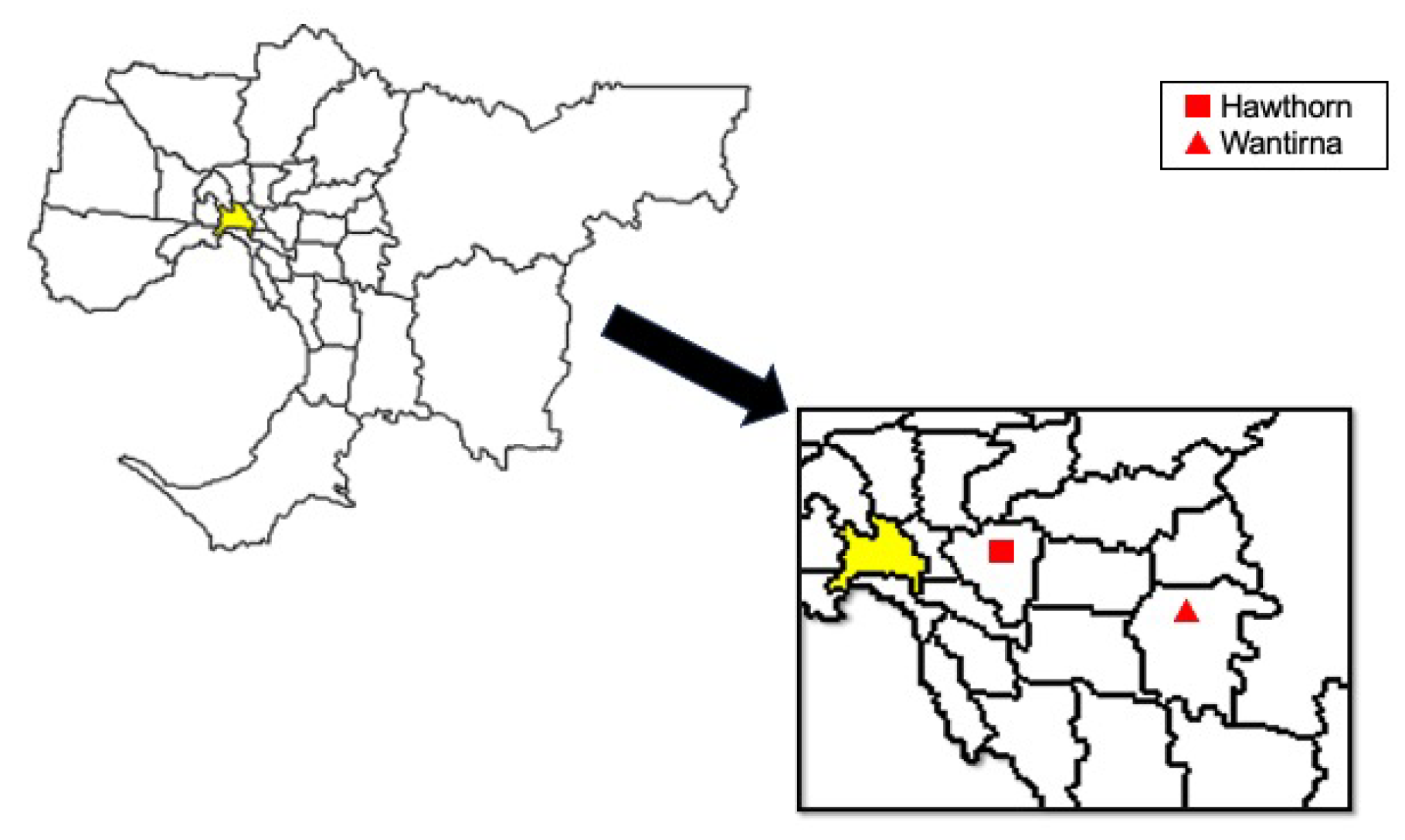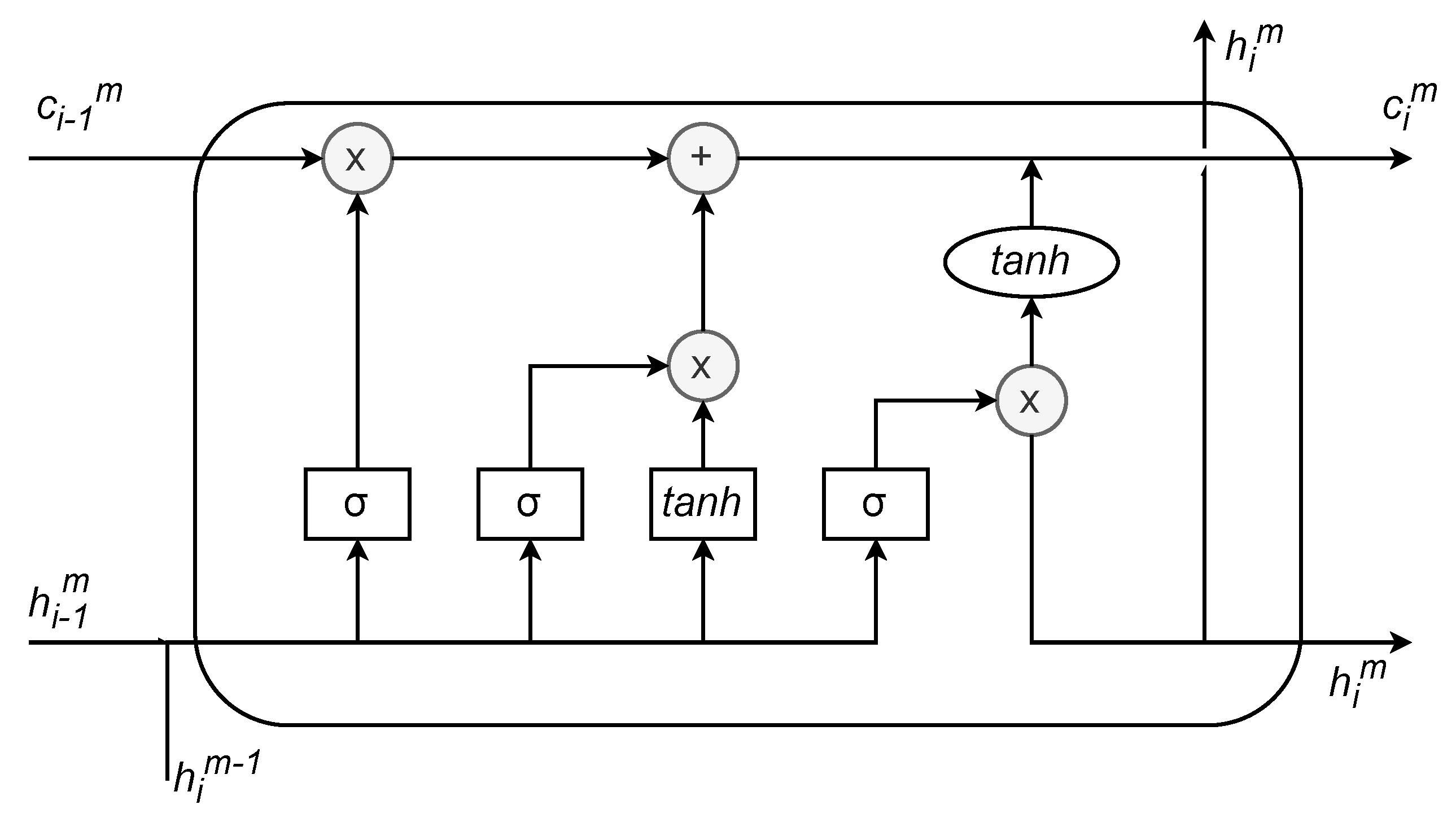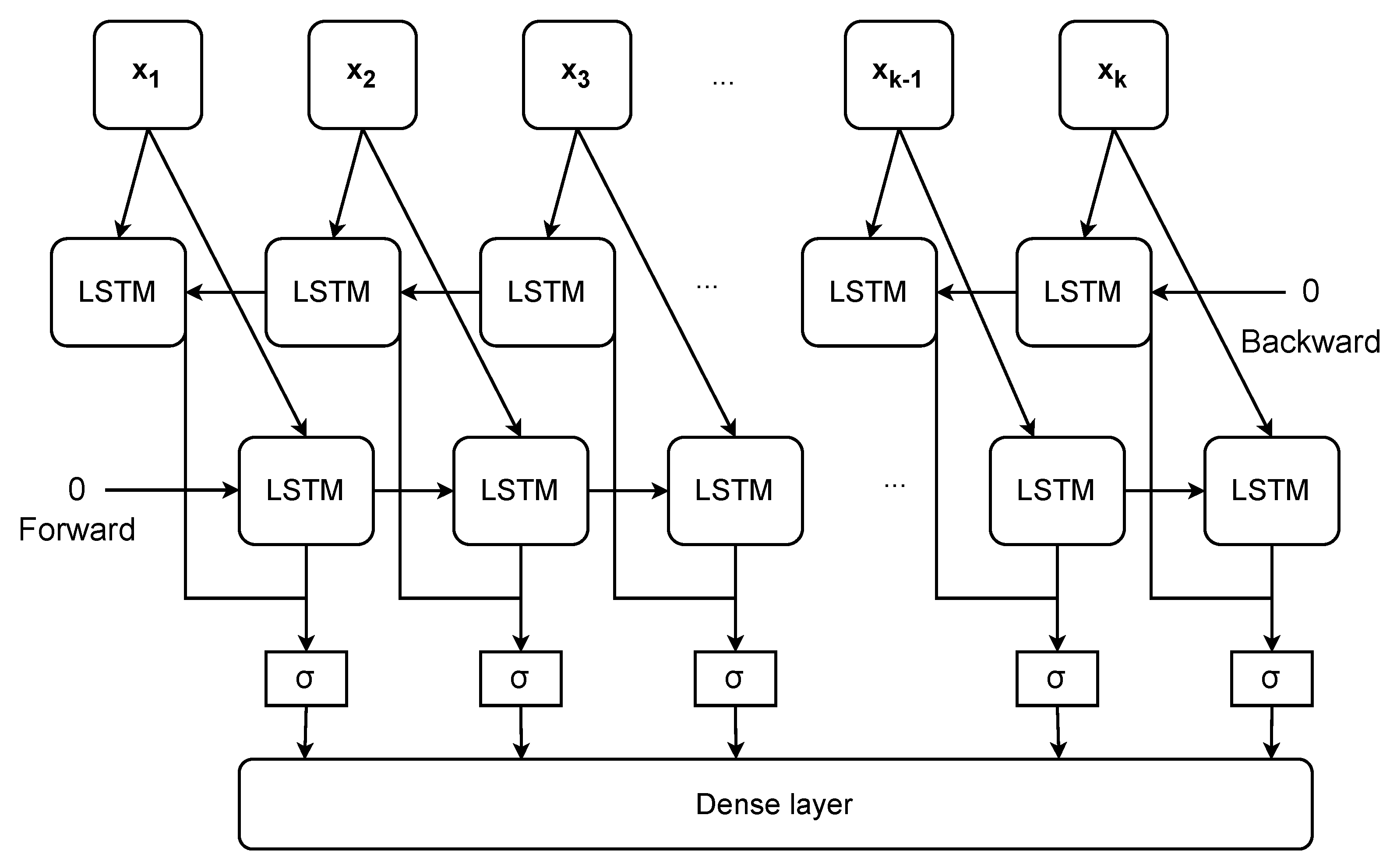Predicting Commercial Building Energy Consumption Using a Multivariate Multilayered Long-Short Term Memory Time-Series Model
Abstract
1. Introduction
2. Background
2.1. Forecasting Models
2.2. Energy Consumption Forecasting
3. Data Used in This Study
3.1. Data Collection
3.2. Data Setup
4. Methodology
4.1. Data Preprocessing
4.2. Forecasting Model—Multivariate Multilayered LSTM
5. Bench-Marking Models
5.1. Linear Regression
5.2. LSTM
5.3. Bidirectional LSTM
5.4. Support Vector Machine
6. Experiment
6.1. Metric
6.2. Result and Discussion
6.2.1. General Performance
6.2.2. Experience Different Models
7. Conclusions
Author Contributions
Funding
Institutional Review Board Statement
Informed Consent Statement
Data Availability Statement
Conflicts of Interest
References
- Khalil, M.; McGough, A.S.; Pourmirza, Z.; Pazhoohesh, M.; Walker, S. Machine learning, deep learning and statistical analysis for forecasting building energy consumption—A systematic review. Eng. Appl. Artif. Intell. 2022, 115, 105287. [Google Scholar] [CrossRef]
- Agrawal, R.; Bhagia, S.; Satlewal, A.; Ragauskas, A.J. Urban mining from biomass, brine, sewage sludge, phosphogypsum and e-waste for reducing the environmental pollution: Current status of availability, potential, and technologies with a focus on LCA and TEA. Environ. Res. 2023, 224, 115523. [Google Scholar] [CrossRef] [PubMed]
- Alok, S.; Ruchi, A.; Samarthya, B.; Art, R. Rice straw as a feedstock for biofuels: Availability, recalcitrance, and chemical properties: Rice straw as a feedstock for biofuels. Biofuels Bioprod. Biorefining 2017, 12, 83–107. [Google Scholar]
- IEA. Clean Energy Transitions in Emerging and Developing Economies; IEA: Paris, France, 2021. [Google Scholar]
- Shin, S.-Y.; Woo, H.-G. Energy consumption forecasting in korea using machine learning algorithms. Energies 2022, 15, 4880. [Google Scholar] [CrossRef]
- Özbay, H.; Dalcalı, A. Effects of COVID-19 on electric energy consumption in turkey and ann-based short-term forecasting. Turk. J. Electr. Eng. Comput. Sci. 2021, 29, 78–97. [Google Scholar] [CrossRef]
- Ji, Y.; Lomas, K.J.; Cook, M.J. Hybrid ventilation for low energy building design in south China. Build. Environ. 2009, 44, 2245–2255. [Google Scholar] [CrossRef]
- Manu, S.; Shukla, Y.; Rawal, R.; Thomas, L.E.; De Dear, R. Field studies of thermal comfort across multiple climate zones for the subcontinent: India Model for Adaptive Comfort (IMAC). Build. Environ. 2016, 98, 55–70. [Google Scholar] [CrossRef]
- Delzendeh, E.; Wu, S.; Lee, A.; Zhou, Y. The impact of occupants’ behaviours on building energy analysis: A research review. Renew. Sustain. Energy Rev. 2017, 80, 1061–1071. [Google Scholar] [CrossRef]
- Itzhak, N.; Tal, S.; Cohen, H.; Daniel, O.; Kopylov, R.; Moskovitch, R. Classification of univariate time series via temporal abstraction and deep learning. In Proceedings of the 2022 IEEE International Conference on Big Data (Big Data) IEEE, Osaka, Japan, 17–20 December 2022; pp. 1260–1265. [Google Scholar]
- Ibrahim, M.; Badran, K.M.; Hussien, A.E. Artificial intelligence-based approach for univariate time-series anomaly detection using hybrid cnn-bilstm model. In Proceedings of the 2022 13th International Conference on Electrical Engineering (ICEENG) IEEE, Cairo, Egypt, 29–31 March 2022; pp. 129–133. [Google Scholar]
- Hu, M.; Ji, Z.; Yan, K.; Guo, Y.; Feng, X.; Gong, J.; Zhao, X.; Dong, L. Detecting anomalies in time series data via a meta-feature based approach. IEEE Access 2018, 6, 27760–27776. [Google Scholar] [CrossRef]
- Niu, Z.; Yu, K.; Wu, X. Lstm-based vae-gan for time-series anomaly detection. Sensors 2020, 20, 3738. [Google Scholar] [CrossRef]
- Warrick, P.; Homsi, M.N. Cardiac arrhythmia detection from ecg combining convolutional and long short-term memory networks. In Proceedings of the 2017 Computing in Cardiology (CinC) IEEE, Rennes, France, 24–27 September 2017; pp. 1–4. [Google Scholar]
- Karim, F.; Majumdar, S.; Darabi, H.; Harford, S. Multivariate lstm-fcns for time series classification. Neural Netw. 2019, 116, 237–245. [Google Scholar] [CrossRef]
- Gasparin, A.; Lukovic, S.; Alippi, C. Deep learning for time series forecasting: The electric load case. CAAI Trans. Intell. Technol. 2021, 7, 1–25. [Google Scholar] [CrossRef]
- Wei, N.; Li, C.; Peng, X.; Zeng, F.; Lu, X. Conventional models and artificial intelligence-based models for energy consumption forecasting: A review. J. Pet. Sci. Eng. 2019, 181, 106187. [Google Scholar] [CrossRef]
- Kim, Y.; Son, H.G.; Kim, S. Short term electricity load forecasting for institutional buildings. Energy Rep. 2019, 5, 1270–1280. [Google Scholar] [CrossRef]
- Chitalia, G.; Pipattanasomporn, M.; Garg, V.; Rahman, S. Robust short-term electrical load forecasting framework for commercial buildings using deep recurrent neural networks. Appl. Energy 2020, 278, 115410. [Google Scholar] [CrossRef]
- Pinto, T.; Praça, I.; Vale, Z.; Silva, J. Ensemble learning for electricity consumption forecasting in office buildings. Neurocomputing 2021, 423, 747–755. [Google Scholar] [CrossRef]
- Pallonetto, F.; Jin, C.; Mangina, E. Forecast electricity demand in commercial building with machine learning models to enable demand response programs. Energy AI 2022, 7, 100121. [Google Scholar] [CrossRef]
- Skomski, E.; Lee, J.Y.; Kim, W.; Chandan, V.; Katipamula, S.; Hutchinson, B. Sequence-to-sequence neural networks for short-term electrical load forecasting in commercial office buildings. Energy Build. 2020, 226, 110350. [Google Scholar] [CrossRef]
- Dagdougui, H.; Bagheri, F.; Le, H.; Dessaint, L. Neural network model for short-term and very-short-term load forecasting in district buildings. Energy Build. 2019, 203, 109408. [Google Scholar] [CrossRef]
- Khan, Z.A.; Hussain, T.; Ullah, A.; Rho, S.; Lee, M.; Baik, S.W. Towards efficient electricity forecasting in residential and commercial buildings: A novel hybrid CNN with a LSTM-AE based framework. Sensors 2020, 20, 1399. [Google Scholar] [CrossRef]
- Karijadi, I.; Chou, S.Y. A hybrid RF-LSTM based on CEEMDAN for improving the accuracy of building energy consumption prediction. Energy Build. 2022, 259, 111908. [Google Scholar] [CrossRef]
- Hwang, J.; Suh, D.; Otto, M.O. Forecasting electricity consumption in commercial buildings using a machine learning approach. Energies 2020, 13, 5885. [Google Scholar] [CrossRef]
- Fernández-Martínez, D.; Jaramillo-Morán, M.A. Multi-Step Hourly Power Consumption Forecasting in a Healthcare Building with Recurrent Neural Networks and Empirical Mode Decomposition. Sensors 2022, 22, 3664. [Google Scholar] [CrossRef] [PubMed]
- Jozi, A.; Pinto, T.; Marreiros, G.; Vale, Z. Electricity consumption forecasting in office buildings: An artificial intelligence approach. In Proceedings of the 2019 IEEE Milan PowerTech, Milan, Italy, 23–27 June 2019; pp. 1–6. [Google Scholar]
- Mariano-Hernández, D.; Hernández-Callejo, L.; Solís, M.; Zorita-Lamadrid, A.; Duque-Pérez, O.; Gonzalez-Morales, L.; Alonso-Gómez, V.; Jaramillo-Duque, A.; Santos García, F. Comparative study of continuous hourly energy consumption forecasting strategies with small data sets to support demand management decisions in buildings. Energy Sci. Eng. 2022, 10, 4694–4707. [Google Scholar] [CrossRef]
- Divina, F.; Torres, M.G.; Vela, F.A.G.; Noguera, J.L.V. A comparative study of time series forecasting methods for short term electric energy consumption prediction in smart buildings. Energies 2019, 12, 1934. [Google Scholar] [CrossRef]
- Johannesen, N.J.; Kolhe, M.; Goodwin, M. Relative evaluation of regression tools for urban area electrical energy demand forecasting. J. Clean. Prod. 2019, 218, 555–564. [Google Scholar] [CrossRef]
- Singhal, R.; Choudhary, N.; Singh, N. Short-Term Load Forecasting Using Hybrid ARIMA and Artificial Neural Network Model. In Advances in VLSI, Communication, and Signal Processing: Select Proceedings of VCAS 2018; Springer: Singapore, 2020; pp. 935–947. [Google Scholar]
- Li, K.; Zhang, T. Forecasting electricity consumption using an improved grey prediction model. Information 2018, 9, 204. [Google Scholar] [CrossRef]
- del Real, A.J.; Dorado, F.; Duran, J. Energy demand forecasting using deep learning: Applications for the french grid. Energies 2020, 13, 2242. [Google Scholar] [CrossRef]
- Fathi, S.; Srinivasan, R.S.; Kibert, C.J.; Steiner, R.L.; Demirezen, E. AI-based campus energy use prediction for assessing the effects of climate change. Sustainability 2020, 12, 3223. [Google Scholar] [CrossRef]
- Khan, S.U.; Khan, N.; Ullah, F.U.M.; Kim, M.J.; Lee, M.Y.; Baik, S.W. Towards intelligent building energy management: AI-based framework for power consumption and generation forecasting. Energy Build. 2023, 279, 112705. [Google Scholar] [CrossRef]
- Athiyarath, S.; Paul, M.; Krishnaswamy, S. A comparative study and analysis of time series forecasting techniques. SN Comput. Sci. 2020, 1, 175. [Google Scholar] [CrossRef]
- Noor, R.M.; Yik, N.S.; Kolandaisamy, R.; Ahmedy, I.; Hossain, M.A.; Yau, K.L.A.; Shah, W.M.; Nandy, T. Predict Arrival Time by Using Machine Learning Algorithm to Promote Utilization of Urban Smart Bus. Preprints.org 2020, 2020020197. [Google Scholar] [CrossRef]
- Ciampiconi, L.; Elwood, A.; Leonardi, M.; Mohamed, A.; Rozza, A. A Survey and Taxonomy of Loss Functions in Machine Learning. arXiv 2023, arXiv:2301.05579. [Google Scholar]
- Bianco, V.; Manca, O.; Nardini, S. Electricity consumption forecasting in italy using linear regression models. Energy 2009, 34, 1413–1421. [Google Scholar] [CrossRef]
- Saab, S.; Badr, E.; Nasr, G. Univariate modeling and forecasting of energy consumption: The case of electricity in lebanon. Energy 2001, 26, 1–14. [Google Scholar] [CrossRef]
- Yuan, X.; Li, L.; Wang, Y. Nonlinear dynamic soft sensor modeling with supervised long short-term memory network. IEEE Trans. Ind. Inform. 2019, 16, 3168–3176. [Google Scholar] [CrossRef]
- Durand, D.; Aguilar, J.; R-Moreno, M.D. An analysis of the energy consumption forecasting problem in smart buildings using lstm. Sustainability 2022, 14, 13358. [Google Scholar] [CrossRef]
- Hochreiter, S.; Schmidhuber, J. Long short-term memory. Neural Comput. 1997, 9, 1735–1780. [Google Scholar] [CrossRef]
- Graves, A.; Schmidhuber, J. Framewise phoneme classification with bidirectional lstm and other neural network architectures. Neural Netw. 2005, 18, 602–610. [Google Scholar] [CrossRef]
- Le, T.; Vo, M.T.; Vo, B.; Hwang, E.; Rho, S.; Baik, S.W. Improving electric energy consumption prediction using cnn and bi-lstm. Appl. Sci. 2019, 9, 4237. [Google Scholar] [CrossRef]











| No. | Forecasting Model | Year | Country | Forecast Horizon | Ref. | Accuracy | ||
|---|---|---|---|---|---|---|---|---|
| MAPE | Normalised-RMSE | MAE | ||||||
| 1 | ANN model with external variables (NARX) | 2019 | Korea | hour ahead | [18] | 1.69% | 85.44 | |
| 2 | Long Short-term Memory Networks with attention (LSTM) | 2020 | USA | hour ahead | [19] | 5.96% | 7.21 | |
| 3 | AdaBoost.R2 | 2021 | Portugal | hour ahead | [20] | 5.34% | ||
| 4 | Support Vector Machine (SVM) | 2022 | Ireland | hour ahead | [21] | 5.3% | 3.82 | 11.94 kW |
| 5 | Seq2seq RNN | 2020 | USA | hour ahead | [22] | 3.74 kW | ||
| 6 | Bayesian regularized (BR) (12 inputs) | 2019 | Canada | hour ahead | [23] | 1.83% | 105.03 kW | |
| Levenberg Macquardt (LM) (12 inputs) | 2019 | Canada | hour ahead | 1.82% | 104.21 kW | |||
| 7 | Hybrid convolutional neural network (CNN) with an LSTM autoencoder (LSTM-AE) | 2020 | Korea | hour ahead | [24] | 0.76% | 0.47 | 0.31 |
| 8 | Hybrid method of Random Forest (RF) and Long Short-Term Memory (LSTM) based on Complete Ensemble Empirical Mode Decomposition with Adaptive Noise (CEEMDA) | 2022 | USA | hour ahead | [25] | 5.33% | 0.57 | 0.43 |
| 9 | Seasonal autoregressive integrated moving average (SARIMAX) | 2020 | Korea | day ahead | [26] | 27.15% | 557.6 kW | |
| 10 | Gated Recurrent Unit (GRU) | 2022 | Spain | day ahead | [27] | 7.86% | 156.11 | |
| 11 | Hybrid Neural Fuzzy Interface System (HyFIS) | 2019 | Portugal | day ahead | [28] | 8.71% | ||
| Wang and Mendel’s Fuzzy Rule Learning Method (WM) | 2019 | Portugal | day ahead | 8.58% | ||||
| A genetic fuzzy system for fuzzy rule learning based on the MOGUL methodology (GFS.FR.MOGUL) | 2019 | Portugal | day ahead | 9.87% | ||||
| 12 | XGBoost | 2022 | Spain | day ahead | [29] | 8.83 | ||
| With Labelled Time | Without Labelled Time | ||||||
|---|---|---|---|---|---|---|---|
| Dataset | Model | Score | Score | ||||
| 0.159 | 0.071 | 0.543 | 0.251 | 0.084 | 0.347 | ||
| LSTM | 0.260 | 0.090 | 0.252 | 0.270 | 0.097 | 0.135 | |
| Bi-LSTM | 0.324 | 0.097 | 0.180 | 0.343 | 0.134 | 0.115 | |
| Linear Regression | 0.285 | 0.094 | 0.191 | 0.311 | 0.093 | 0.216 | |
| SVM | 0.239 | 0.074 | 0.490 | 0.258 | 0.081 | 0.310 | |
| 0.139 | 0.034 | 0.831 | 0.176 | 0.044 | 0.719 | ||
| LSTM | 0.385 | 0.075 | 0.156 | 0.495 | 0.091 | −0.230 | |
| Bi-LSTM | 0.352 | 0.087 | 0.143 | 0.476 | 0.093 | −0.258 | |
| Linear Regression | 0.167 | 0.034 | 0.827 | 0.345 | 0.069 | 0.291 | |
| SVM | 0.208 | 0.058 | 0.248 | 0.388 | 0.078 | 0.122 | |
| 0.072 | 0.130 | 0.506 | 0.099 | 0.134 | 0.399 | ||
| LSTM | 0.184 | 0.146 | 0.378 | 0.431 | 0.144 | 0.395 | |
| Bi-LSTM | 0.449 | 0.331 | −2.196 | 0.814 | 0.295 | −1.536 | |
| Linear Regression | 0.312 | 0.182 | 0.035 | 0.390 | 0.138 | 0.141 | |
| SVM | 0.192 | 0.136 | 0.404 | 0.397 | 0.147 | 0.341 | |
Disclaimer/Publisher’s Note: The statements, opinions and data contained in all publications are solely those of the individual author(s) and contributor(s) and not of MDPI and/or the editor(s). MDPI and/or the editor(s) disclaim responsibility for any injury to people or property resulting from any ideas, methods, instructions or products referred to in the content. |
© 2023 by the authors. Licensee MDPI, Basel, Switzerland. This article is an open access article distributed under the terms and conditions of the Creative Commons Attribution (CC BY) license (https://creativecommons.org/licenses/by/4.0/).
Share and Cite
Dinh, T.N.; Thirunavukkarasu, G.S.; Seyedmahmoudian, M.; Mekhilef, S.; Stojcevski, A. Predicting Commercial Building Energy Consumption Using a Multivariate Multilayered Long-Short Term Memory Time-Series Model. Appl. Sci. 2023, 13, 7775. https://doi.org/10.3390/app13137775
Dinh TN, Thirunavukkarasu GS, Seyedmahmoudian M, Mekhilef S, Stojcevski A. Predicting Commercial Building Energy Consumption Using a Multivariate Multilayered Long-Short Term Memory Time-Series Model. Applied Sciences. 2023; 13(13):7775. https://doi.org/10.3390/app13137775
Chicago/Turabian StyleDinh, Tan Ngoc, Gokul Sidarth Thirunavukkarasu, Mehdi Seyedmahmoudian, Saad Mekhilef, and Alex Stojcevski. 2023. "Predicting Commercial Building Energy Consumption Using a Multivariate Multilayered Long-Short Term Memory Time-Series Model" Applied Sciences 13, no. 13: 7775. https://doi.org/10.3390/app13137775
APA StyleDinh, T. N., Thirunavukkarasu, G. S., Seyedmahmoudian, M., Mekhilef, S., & Stojcevski, A. (2023). Predicting Commercial Building Energy Consumption Using a Multivariate Multilayered Long-Short Term Memory Time-Series Model. Applied Sciences, 13(13), 7775. https://doi.org/10.3390/app13137775









